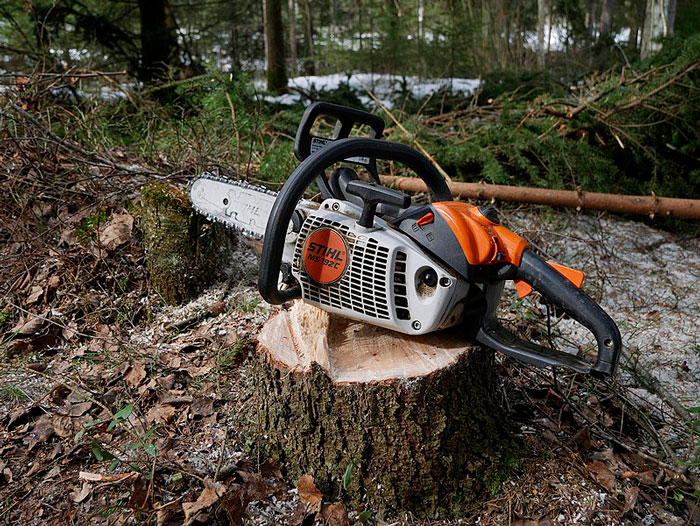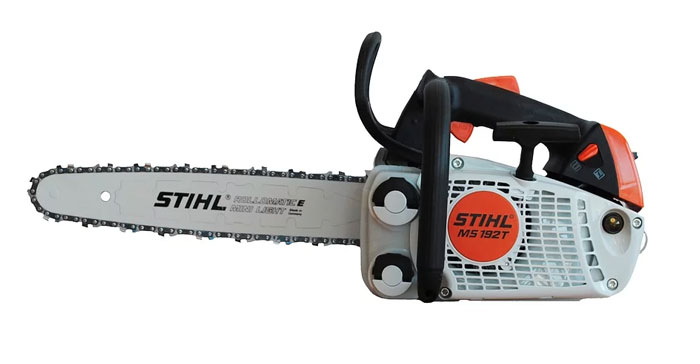Chainsaws are undoubtedly amongst the most daunting tools. No one who has seen a chainsaw in their lifetime will doubt the ability of the machine to cut down a tree effortlessly (or chop one’s limbs off, for that matter).
It goes without saying that as a beginner, you would need a guide to help make the process easier and less scary and we’re here to deliver just that!
How to Choose a Chainsaw?
What’s the point of looking into features, all chainsaws do the same thing, right? Well, that couldn’t be farther from the truth. Like any other power tool, your weapon of choice will vary based on your specific needs. Regardless of what your burly, tool-nerd neighbor says, no, you cannot just purchase any chainsaw and go to town.

If you’re a beginner, opt for electric chainsaws as they are accessible to power up and have blades ranging from 8” to 12”. The size makes it convenient for ‘noobs’ and professionals alike. You may expect a price tag between $100 and $250 for some of the best electric chainsaw models with well-rounded features.
Light duty chainsaws are also an excellent option for beginners, and they come with more power than electric chainsaws. Besides small yard work, light duty chainsaws can take on small branch clearing.
Mid to heavy-duty chainsaws should only be handled by those who have prior and extensive experience. 14″ to 16″ saw blades are perfect for heavy-duty yard work, cutting heavy limbs, and bucking trees. Blades are 18,” and above are best left for cutting large trees.
If you’re reading this guide, you should probably steer clear of professional chainsaws. Professional chainsaws, as the name suggests, is best reserved for those who make a living out of sawing.
However, if you would still love some recommendations, we suggest you check out Remington chainsaw reviews for some of the best options.
You may be looking to cut trees or clear out messy branches, but you would be better off not using the same saw for both of these tasks. Longer bars are designed to cut branches whereas felling is made easier by shorter bars.
Before You Start Sawing
Once you’ve picked your chainsaw, you’re ready to make the first cut. Before you do so, ensure that the chain is placed correctly on the bar at the right tension. If the tension is off, the chain might go off-track and result in injuries. Additionally, check for loose bolts and parts on the body of the chainsaw.

Ensure that the fuel tank is full before starting the saw. Furthermore, all the parts of your chainsaw should be well lubed and sharpened before use. If your chainsaw is producing dust instead of chips, you’ll know it’s time to sharpen it.
Safety Basics
Kickback can, potentially, be fatal. It can occur when the ‘nose’ of the chain gets caught in any sort of debris in the bark or trunk. As a result, the chainsaw will jerk and push back towards the user.

To prevent kickback, be sure to purchase a chainsaw that you can hold with both hands and balance well. Anything too heavy will increase your chances of being injured during kickback. Hold the chainsaw with both hands at all times, keeping it as stable as possible.
Prevent the nose from coming into contact with any material to reduce the chances of it getting caught. Be more cautious while dealing with lighter or less dense material, as well. Ensure the chain brakes are in place and working properly prior to powering the chainsaw.
Purchasing the correct protective gear is just as important as picking the right saw. Keep your eyes shielded against dust and splinters with visors or goggles. A helmet might just save your life if you’re looking to cut down a tree as branches (or the tree itself, at times) may just fall on your head and cause serious injuries.
You would preferably want to be bulletproof while using a chainsaw literally. Chainsaw chaps and chainsaw gloves made of Kevlar will stop the chainsaw from cutting into your skin so the chances of losing a limb are decreased drastically, if not eliminated. Safety toe boots are a great addition to your arsenal, too.
Inspect the area where you will be working carefully. Clear the ground of anything that you may trip on such as loose branches, debris, stones, cables, etc. Moreover, if you are prepping to cut a tree, ensure that the tree has a clear path to fall through. You would not want the tree to take with it everything in its route.
See? It does not take much to avoid accidents, no matter how intimidating the tool may be.
Getting Down to Business
Here comes the fun part actually getting to use your chainsaw!
First things first, you need to know how to fire it up. The positioning of the tool during startup is very important. You can either place in on the ground while you pull the ropes, or you may also place in firmly between your legs. Whichever method you chose, ensure that the chainsaw is stable while it’s being turned on.
If you’re using an electric chainsaw, then you have it easy. However, for gas-fueled chainsaws, it’s a bit more complicated. Firstly, push the chain brake forward to engage it. If your model has a decompressive valve, this is where you would push it as it helps start up the engine which in turns powers your chainsaw.
More advanced models have primer bulbs, which help to reduce the number of times you need to pull the rope to get your tool to start. So if yours has got one, press it repeatedly. Next, push down the choke or master control. Stabilize the chainsaw on the ground (recommended) with your foot and pull the rope till the tool fires up.

At this point, you will notice that the life of the engine was quite short-lived much like your dreams of mastering the chainsaw. Fret not, because all you have to do is lift the choke one notch and pull the rope again. Your engine will fire back up in no time.
Lift the chainsaw off the ground and grasp onto the handlebar while pulling the chain brake towards yourself. You should hear a click, and that’s when you’re ready to turn the bar on.
This point onwards, the tool has done its job. All you have to do is apply appropriate pressure, which will vary from task to task. However, you definitely won’t have to break a set and work your muscles to soreness as a beginner.
Moreover, once it’s switched on, try making a cut on a practice piece. Having slabs to practice on is essential for beginners, but pros can benefit from it too, as it helps to test the sharpness, placement, and lubrication before starting the main task.
Maintaining Your Chainsaw
We know you’re impatient to get yourself a chainsaw and get to work, but we recommend you stick by for a couple of minutes to see how you can maintain your toy and improve its longevity.
Keep your tools sharpened at all times. It may be difficult to carry elaborate sharpening tools with you from job to job, but there are several portable options on the market that can get the job done just fine.
Lubrication is also an important process in maintenance. Not only does it allow all the parts to move smoothly, but it also keeps any sort of rust from forming and reactions from occurring on the blade or body of the chainsaw.
Clean the blades off of any sawdust, debris, etc. It will generally hamper the sharpness of the blade as well as hamper the quality of your next task. Having debris lodged in your bar can also lead to kickbacks and we know by now how unsavory those are.
To prevent the chainsaw from starting on a half-full or empty tank, you should keep the fuel tank filled at all times. Otherwise, it will greatly hamper the lifespan of your tool. Also, after each use, cool both the engine and bar fully before stowing the chainsaw away for future use.
Final Words
There you have it! That is as basic as it gets with chainsaws. We hope you will benefit from our guide and find yourself a new hobby soon. With the correct tool, protective gear, and training, you’ll be slicing through giant trees and chopping up your own firewood in no time.

